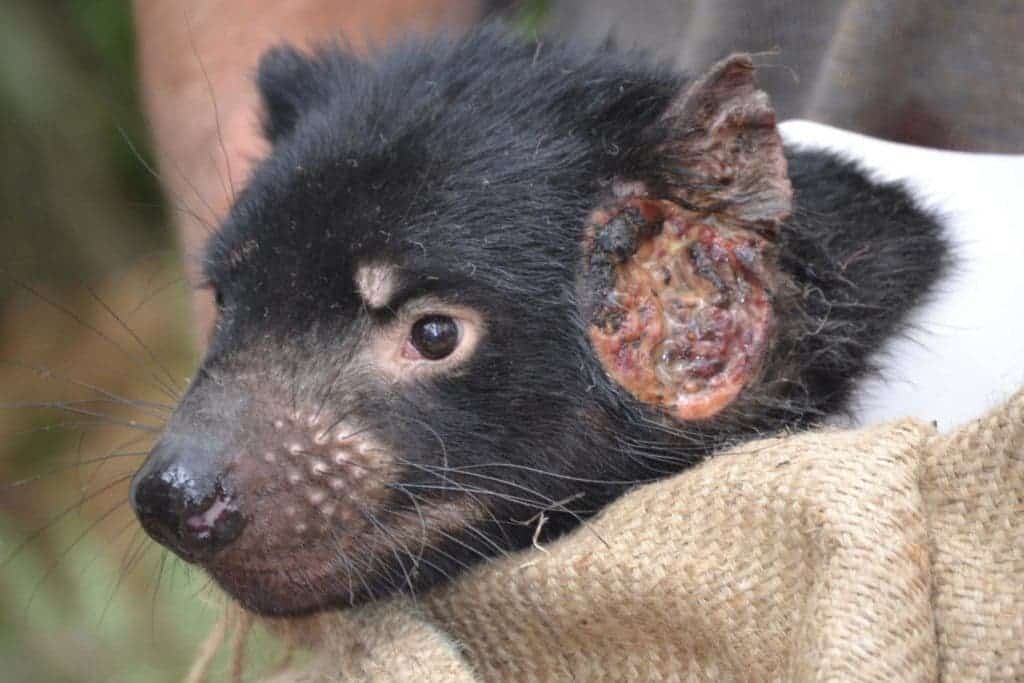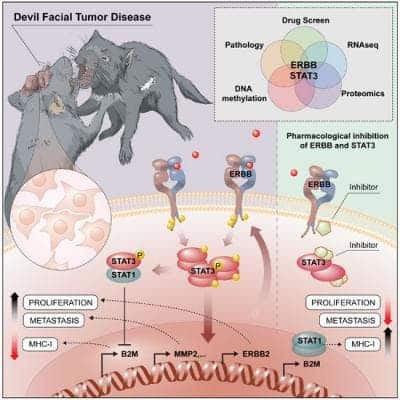
There are more than 200 types of cancers that afflict humans, with lung, breast, prostate, and bowel cancer accounting for more than half of the cases. More than 1 in 3 people will develop some form of cancer during their lifetimes. Yes, cancer is the stuff of nightmares but imagine what it would be like if it were transmissible like an infectious disease. For the Tasmanian devil, this nightmare is part of their everyday reality.
In 1996, the first case of devil facial tumor disease (DFTD) was reported by scientists. It’s only one of three transmissible cancers known to man (the other being in dogs and shellfish), but also one of the most unforgiving having an almost 100% kill rate. Today, the population of the iconic Australian marsupial is down 90% and many researchers fear the devil may be doomed for unless something is done about it — and fast. Now, an international team of researchers has reported finding the molecular mechanisms responsible for the transmission of cancer among the marsupials, with the potential of a new therapeutic pathway that might save the species from obliteration.
Previous investigations showed that cancer is transmitted from one Tasmanian devil to the other by bites. This certainly doesn’t bode well for a species which is notorious for its highly aggressive behavior. When scientists examined tumor samples from different individuals, they noticed that all the cells were genetically identical, presumably deriving from a single cell of origin.
Researchers at the CeMM Research Center for Molecular Medicine of the Austrian Academy of Sciences and the Vienna University of Veterinary Medicine performed experiments on cell tumors from Tasmanian devils. Their investigation revealed that receptor molecules on the surface of the cancer cells (ERBB receptors) have a hugely increased activity compared to samples taken from other creature (i.e. humans). This high activity triggers a biochemical reaction within the cells, thereby activating STAT3 proteins — transcription factors that alter the cell’s genetic program. The reprogrammed cells have fewer molecules that serve as identification for the immune system, while at the same time proliferation is accelerated and factors for metastasis are produced.
“Our experiments show for the first time that the excessive activation of ERBB receptors and STAT3 proteins play a key role in the transmissibility of the Tasmanian devil´s facial tumor,” Lindsay Kosack, a researcher at CeMM and co-first author, said in a statement. “Above that, we showed in further experiments that the inhibition of ERBB receptors with a drug can selectively kill the cancer cells. This could play an important role for the treatment of the disease, before the Tasmanian devil becomes extinct.”

What’s intriguing is that 99.1% of the devil’s STAT3 are identical to the human variant and many of the genes activated by the protein are also active in human cancers. Thus, this rare phenomenon might offer new exciting opportunities to study cancer metastases. But before you get too worried, the researchers assure us that a similarly transmissible cancer in humans is almost impossible.
“Apart from the molecular mechanisms that would need to evolve are humans genetically much more diverse and resistant than the isolated population of the Tasmanian devils. The aggressive biting behavior of the animals also seems to play an important role in tumor transmission. Nevertheless, a better molecular understanding of this rare disease can provide valuable insights on fundamental biological mechanisms of cancer development,” Andreas Bergthaler, Principal Investigator at CeMM and first author of the new study, said in a statement.
Fortunately, there are people working on multiple fronts to save the devils. Besides this newly identified molecular mechanism, researchers previously found that the two types of cancer known to affect devils delete genes responsible for cancer recognition in the immune system. This is achieved with the help of molecules called receptor tyrosine kinases. The good news is that there are already drugs developed for humans that target these molecules, which seem to halt the growth of Tasmanian cancer cells in the lab.
Another promising study found that although DFTD kills most of the devils it comes across, those that survive seem to have genetic qualities that protect them. In time, researchers hope that new devil populations become immune to transmissible cancer. However, fragile populations with few members need to be protected from other threats such as loss of habitat and climate change.
The findings appeared in the journal Cancer Cell.


